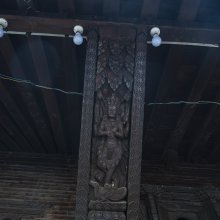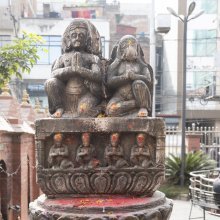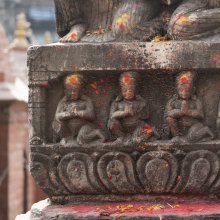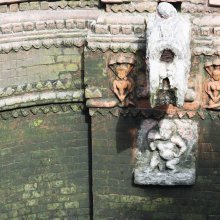Khat, Khaṭ, Khāṭ, Khāt: 10 definitions
Introduction:
Khat means something in Hinduism, Sanskrit, Hindi, biology. If you want to know the exact meaning, history, etymology or English translation of this term then check out the descriptions on this page. Add your comment or reference to a book if you want to contribute to this summary article.
Images (photo gallery)
(+30 more images available)
Biology (plants and animals)
Source: Google Books: CRC World Dictionary (Regional names)1) Khat in English is the name of a plant defined with Catha edulis in various botanical sources. This page contains potential references in Ayurveda, modern medicine, and other folk traditions or local practices It has the synonym Dillonia abyssinica Sacleux (among others).
2) Khat in Pakistan is also identified with Olea europaea.
3) Khat in Senegal is also identified with Andropogon gayanus It has the synonym Cymbachne guineensis (Schumach.) Roberty (etc.).
Example references for further research on medicinal uses or toxicity (see latin names for full list):
· A Voyage to Terra Australis (1814)
· Bulletin de la Société Botanique de France (1908)
· Fl. W. Tropical Africa ed. 2 (1972)
· Enum. Hort. Berol. Alt. (1821)
· Fitoterapia (1991)
· Kongel. Danske Vidensk. Selsk. Naturvidensk. Math. Afh. (1828)
If you are looking for specific details regarding Khat, for example chemical composition, side effects, diet and recipes, extract dosage, health benefits, pregnancy safety, have a look at these references.

This sections includes definitions from the five kingdoms of living things: Animals, Plants, Fungi, Protists and Monera. It will include both the official binomial nomenclature (scientific names usually in Latin) as well as regional spellings and variants.
Languages of India and abroad
Sanskrit dictionary
Source: DDSA: The practical Sanskrit-English dictionaryKhaṭ (खट्).—1 P. (khaṭati) To desire, wish.
--- OR ---
Khāṭ (खाट्) or Khāt (खात्).—ind. The sound made in clearing the throat; खात्कृ (khātkṛ) to clear the throat (Mar. khākaraṇeṃ).
Source: Cologne Digital Sanskrit Dictionaries: Shabda-Sagara Sanskrit-English DictionaryKhaṭ (खट्).—[khaṭa] r. 1st cl. (khaṭati) To desire, to wish, to seek or inquire.
Source: Cologne Digital Sanskrit Dictionaries: Benfey Sanskrit-English DictionaryKhaṭ (खट्).—i. 1, [Parasmaipada.] To desire.
Source: Cologne Digital Sanskrit Dictionaries: Cappeller Sanskrit-English DictionaryKhāt (खात्).—= khāṭ.
Source: Cologne Digital Sanskrit Dictionaries: Monier-Williams Sanskrit-English Dictionary1) Khaṭ (खट्):—1. khaṭ [class] 1. [Parasmaipada] ṭati, to desire, [Dhātupāṭha]
2) 2. khaṭ ind. a particle of exclamation, [Taittirīya-āraṇyaka iv, 27.]
3) Khāṭ (खाट्):—ind. (onomatopoetic) ‘the sound made in clearing the throat’, in [compound] with
4) Khāt (खात्):—[varia lectio] for khāṭ q.v.
Source: Cologne Digital Sanskrit Dictionaries: Yates Sanskrit-English DictionaryKhaṭ (खट्):—khaṭati 1. a. To desire; to seek.
[Sanskrit to German]
Sanskrit, also spelled संस्कृतम् (saṃskṛtam), is an ancient language of India commonly seen as the grandmother of the Indo-European language family (even English!). Closely allied with Prakrit and Pali, Sanskrit is more exhaustive in both grammar and terms and has the most extensive collection of literature in the world, greatly surpassing its sister-languages Greek and Latin.
Hindi dictionary
Source: DDSA: A practical Hindi-English dictionary1) Khat in Hindi refers in English to:—(nf) sound produced by the impact of one object on another, sound of knocking, rap; —[khata] rapping, rap-trap; knocking;broil, quarrel..—khat (खट) is alternatively transliterated as Khaṭa.
2) Khat in Hindi refers in English to:—(nf) a cot, bedstead; —[khatola] household effects; —[todana] to keep on lying idle; —[para padana] to be bed-ridden; —[se utara jana] to be on the verge of death; —[sena] to be confined to bed through prolonged illness; —[se lagana] to be reduced to skeleton, to be emaciated..—khat (खाट) is alternatively transliterated as Khāṭa.
3) Khat in Hindi refers in English to:—(nm) fovea, fossa..—khat (खात) is alternatively transliterated as Khāta.
...
See also (Relevant definitions)
Starts with (+337): Khat ambadi, Khat khao, Khat khiri, Khat palak, Khat papri, Khat-bor, Khat-khatumbo, Khata, Khata limbu, Khata Sutta, Khata-Kana-Kana-Kara, Khatabahi, Khatabaki, Khatabata, Khatabhu, Khatabhuta, Khatada, Khatadi, Khataga, Khatagula.
Ends with (+7): Adalati-likhat, Alikhat, Bara okhat, Bari okhat, Chawngduma-saingho-chi-khat, Dastakhat, Farkhat, Hnahkhat, Khatakhat, Khatikhaat, Khingkhih-chi-khat, Lehngo-chi-khat, Likhat, Manakhat, Mutpharkhat, Natkhat, Phet-sangkhat, Prenkhat, Prollikhat, Reng-an-chi-khat.
Full-text (+21): Khatkri, Khata, Khataka, Katunka, Khat ambadi, Ma-khat-nat-nam, Khat papri, Khat khiri, Khatakhata, Khat-bor, Khat palak, Khat khao, Tukhm khat ni, Khati, Khat-khatumbo, Khamti, Khatini, Prollikhat, Likhat, Khingkhih-chi-khat.
Relevant text
Search found 4 books and stories containing Khat, Khaṭ, Khāṭ, Khāt, Khaat; (plurals include: Khats, Khaṭs, Khāṭs, Khāts, Khaats). You can also click to the full overview containing English textual excerpts. Below are direct links for the most relevant articles:
Amid the Walls < [April - June 1975]
Bandopanth & Bus Ticket < [October – December, 1996]
The Gods of the Egyptians Vol 1 (by E. A. Wallis Budge)
Chapter XI - The Legend Of Rā And Isis
Version A < [Chapter VIII - The History Of The Creation Of The Gods And Of The World]
Folk Tales of Gujarat (and Jhaverchand Meghani) (by Vandana P. Soni)
Chapter 39 - Parkaya Pravesh < [Part 5 - Rang Chee Barot]
Chapter 7b - Kanara ne Reesamne < [Part 2 - Sorathi Baharvatiya]
Shakti and Shakta (by John Woodroffe)
Chapter IV - Tantra Śāstra and Veda < [Section 1 - Introductory]





